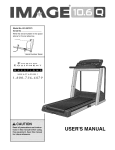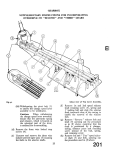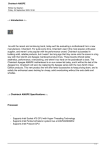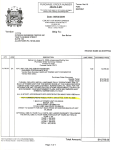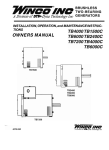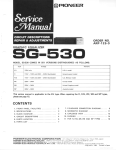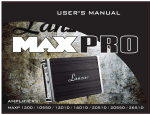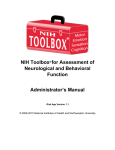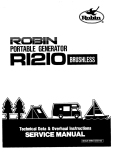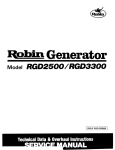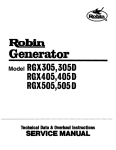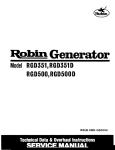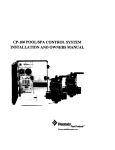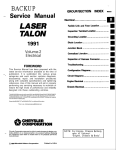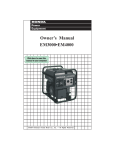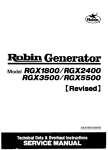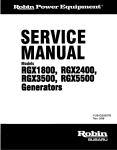Download RGD3700 / RGD5000 GENERATOR SERVICE MANUAL
Transcript
~oIdn Model RGD3 G ator O/RGDSOOO I ISSUE EMD-GS0572 ] CONTENTS Page Title Section 1. SPECIFICATIONS .: ..... ........................................ 2 2 2. PERFORMANCE ............................................... 2-1 Model RGD3700 Model RGD5000 ......................................... 2-2 2-3 DC Output 3. FEATURES 4. GENERAL 4- 1 4-2 4-3 7 . ........... OF GENERATOR ....................... External View of Generator ................................. Control Panel ............................................ Location of Serial Number and Specification Number 5. CONSTRUCTION 5-1 5-2 5-3 5 ..................................... DESCRIPTION AND FUNCTION ............. .............................. Construction ............................................ Function ............................................... Description of Generator Operation ........................... 6. SAFETY PRECAUTIONS ....................................... 7. RANGE OF APPLICATIONS .................................... PROCEDURES .................................... Measuring Instruments ..................................... AC Output Measuring ..................................... Measuring Insulation Resistance .............................. 8. MEASURING 8-1 8-2 8-3 9. CHECKING 9-1 9-2 9-3 -9-4 9-5 9-6 9-7 FUNCTIONAL MEMBERS ............................ Pilot Lamp ............................................... AC Receptacles .......................................... Curcuit Breaker .......................................... Stator .................................................. Rotor .................................................. Condenser ....... .._ .................................... Diode Rectifier ........................................... 10. DISASSEMBLY AND ASSEMBLY 10-1 10-2 10-3 10-4 10-5 1 ................................ Preparation and Precautions ................................. Special Tools for Disassembly and Assembly .................... Disassembly Procedures .................................... Assembly Procedures ...................................... Checking, Disassembly and Reassembly of the Control Box ......... 8 9 9 10 18 19 19 19 23 26 27 30 30 32 32 34 34 34 35 35 36 37 37 38 38 38 39 48 59 Section Page Title 11. TROUBLE SHOOTING ......................................... 11-1 11-2 11-3 11-4 No AC Output ........................................... AC voltage is too high or too low .. ........................... AC voltage is normal at no-load, but the load cannot be applied No DC Output ........................................... 12. WIRING DIAGRAM ........................................... 60 ..... 60 62 63 64 65 Model __~. .-. Type -._ .- RGD3700 - Brushless, Revolving Field, Self-exciting, _. 6OHZ _--. .- Frequency -Maximum Output 50Hz -.-3500w . - 3300w __ . Rated Current Model .-. 4BOOW 11ov -.30.OA -._.. . _ 11ov 120v 27.5A 220V _-. 220v Voltage Power Factor ._-- . DC output -. -Voltage Reyulator . Voltaye Regulation .&C 2-pole, Single Phase - ._ ._50Hz 3700w 3ooow Rated Output RGD5000 .- -_-__- I 30.OAf15.OA 27.5AlI ._ 3.8A . ..___ _. __--- Air-Cooled 39.lAll9.5A __---..--._ 10% -----. _ 4-Cycle Diesel Engine .. -. -.____ . I -- 17.9A _-_ Within - -- 19.5A - (1OOW) -_. Condenser Type -.-. - - 12V-8.3A _. 39.1A _-_ 1.0 - -__ _- 240V _ _._. 1 lOVi22OV 15.OA 1 lOVf22OV .12OVl24OV -_.._ .- - 4300w - -.- SOHi 5ooow 4500w 11ov 120\/’ 22OV 11 OVl22OV -12OVf24OV __ ..40.9A - --37.5A . .__ _ 20.5A 40.9Af 20.5A 37.5All8.8A __,-- --_. ,,-.- ._ -_ - ___ - .__._-__ ,_. .-_- -- .-- Displacement - _.._ Maximum Output. -----._ .Fuel -.._-. Fuel Tank Capacity ---__ Fuel Consumption 6.0 PSI3000 rpm -. _...14 liters (3.6 U.S. gal.) .-..__--. 50Hz: 1.2 liters/hour 6OHz: 1.5 liters/hour ._.. . 1 .O liter (2.1 U.S. pints) .._. -_-_. Ratio .-- Oil Capacity _.Starting System Dimensions . .- -.. L x W x H __ Dry Weight Automotive .-- ._ . 673 x 500 x 514 mm (26.5 x 19.7 x 20.2 in.) . ..__.---..85 kg (186 Ibs.) ._ type, Diesel Fuel __ -----_. -. _- .- 1 -__ Recoil starter and Electric starter -. .- --I- --. .16 liters (4.2 U.S. gal.) __--.- .__..50Hz: 1.7 liters/hour 60Hz: 2.0 liters/hour - -1 .l liters (2.3 U.S. pints) -- . ..__ -. ._673 x 500 x 542 mm (26.5 x 19.7 x 21.3 in.) ---...., _i9 kg (218 Ibs.) ____- __-.--- 2. PERFORMANCE CURVES 2-l MODEL RGD3700 RGD3700 N = ;r y Output Max. 52 51 Rated Y50 t 49 3k aIL 120 ,’ 110 2 l- 100 5: .............. 3500W 3000W Frequency ................. 50Hz Voltage ................... 11ov I 2 I* ............... z kz lk 2 ? 0 5 10 15 20 CURRENT IA)- 25 30 35 RGD3700 63 Output Max. 62 .............. 3700W 61 Rated 60 Frequency ................. 60Hz Voltage ................... 120v CURRENT 3300W (A) - L I 53 2 52 4 Y ............... RGD3700 Output Max. ............... 3500W 51 Rated 50 Frequency ................. 50Hz 49 Voltage. 220v El z I 230 z’ 220 210 % ? 0 5 CURRENT 10 (A) - 15 -2- .............. .................. 3000W RGD3700 63 - -4k Output Max. 62 Rated 61 -3k I 60 59 -2k 230 -1k z ; ............... .............. 3700W 3300W Frequency ................. 60Hz Voltage. 220v .................. c i$ 220 210 0 10 15 5 CURRENT (A) - 20 RGD3700 53 Output Max. 52 ............... .............. 3500W 51 Rated 3000W 50 Frequency ................. 50Hz Voltage ................... 240V 250 240 230 10 0 :“RRENT 14 (A) - RGD3700 53 Output Max. 52 Rated 51 ............... .............. Frequency ................. Voltage ................ I --3k 230 i 220 z 210 . . 2k 5 a 5 lk0 t 0 5 10 15 CURRENT 20 (Al - 25 30 -3- 3500W 3OOOW 50Hz 1 lOVl22OV I RGD3700 62 63 Output Max. 9 6t z 60 5 59 2 ; 230 u 220 I 210 120 2 110 ; 100 Rated ............... .............. -4k Frequency ................. -3k Voltage ................ t 3700W 33OOW 6OHz 1 lOVI22OV 3 -2k '; 2 -1k 2 -0 $1111111111111111 > 0 5 10 15 CURRENT 20 (A)- 25 30 35 RGD3700 Output Max. z 61 $ 60 ": cl 59 I Rated 130 ; 120 g 110 .............. Frequency : ................ Voltage. 230 s ‘;; ............... I 0 I I 5 I I I I I I I I I I I I 10 15 CURRENT 20 IA) - 25 30 35 -4- ............... 3700W 3300W 6OHz 12OVl24OV 2-2 MODEL RGD5000 53 RGD5000 52 Output Max. 51 Rated -4k 50 0 10 20 CURRENT (A)- 30 -3k f -2k z bj -1k E 2 ............... .............. 4800W 4300W Frequency ................. 50Hz Voltage ................... 11ov 40 RGD5000 ; 63 E 62 z” Lu 2 UJ a II. 61 Output Max. -5k Rated -4k 60 -3k I e -2k 2 -1k 2 o 59 ............... .............. 5000W 4500W Frequency ................. 60Hz Voltage ................... 120v -0 0 t 10 20 CURRENT 30 40 50 (AJ- 52 53 RGD5000 - 5k Output Max. I Rated -- 4k 51 I Ill .*3k 49 E .,2k 2 2 2 + . . lk 230 5 1. r 0 5 10 CURRENT 15 (A) - 20 25 -5- ............... .............. 4800W 4300W Frequency ................. 50Hz Voltage ................... 220v RGD5000 63 - 5k Output Max. 62 61 ............... Rated .4k 60 -3k I -2k 3 5 -1k 2 ‘0 .............. 5000W 4500W Frequency ................. 60Hz Voltage ................... 220v -0 0 5 10 CURRENT 15 20 (Al - 53 - 5k RGD5000 Output . . 4k ............... Rated r t 3 - Max. .............. 4800W 4300W Frequency ................. 50Hz Voltage ................... 240V 250 240 -0 230 z 2 J F 0 5 lo CURRENT 15 (A) - 20 25 A 53 RDG5000 52 p 51 ; 50 Y Output Max. ............... Rated 49 Frequency. 5k I 4k j2k lk I 0 > i’ 0 5 10 15 20 CURRENT 25 30 35 40 45 (Al - -6- .............. ................ Voltage ................ t g o 4800W 4300W 50Hz 1 lOVf22OV 63 I -- FREQUENCY 62 2 61 4 60 5 I I I I RGD5000 I Output Max. . . . . . . . . . . . . . . . 5000W (22OVb-, 5k 59 I 3k s 5 E s 220 I 210 2k 120 lk 2 w a 110 $ loo1 . . . . . . . . . . . . . . 4500W Frequency . . . . . . . . . . . . . . . . . 4k ,o .Fy 230 Rated Voltage.. 60Hz . . . . . . . . . . . . . . llOV/12OV 0 > 1 1 5 1 1 1 10 1 1 1 15 1 20 CURRENT 1 25 1 1 30 1 1 35 1 1 40 1 1 ] 45 (A) - RGD5000 Output Max. Rated ............... .............. Frequency ................. T5k I- 5000W 4500W 6OHz Voltage . . . . . . . . . . . . . . . . 12OVI24OV 4k t 3k 240 A z 230 I 0 5 10 15 20 25 CURRENT 30 35 40 0 45 (A) - 2-3 DC OUTPUT (RGD3700, RGD5000) - I ; 14 2 12 g 10 ’ ‘-cl=4 2 4 CURRENT 6 (A) - ................ 12v DC Ampere ................ 8.3A DC Output ................ 1oow The voltage curve shown in the left indicates the characteristic of DC output when charging a battery. The voltage may be decreased by 20% when the resistance load is applied. NOTE: 0 DC Voltage 6 10 -7- It is possible to use both DC and AC outputs simultaneously up to the rated output in total. 3. FEATURES 3-1 BRUSHLESS ALTERNATOR Newly developed brushless alternator eliminates troublesome brush maintenance. 3-2 EASY STARTING Light pull recoil starter accompanied with automatic decompression system makes the new RGD series generators even easier in starting than gasoline engine generators. 3-3 QUIET OPERATION The new RGD series generator provides quiet operation by means of: 0 The superb design of intake-exhaust system. 0 Direct injection combustion system. l A large super silent muffler. l An efficient low noise air cleaner. 3-4 ECONOMICAL PERFORMANCE On top of well known diesel economy, the air-cooled Robin diesel engine features direct fuel injection and special design refinements for extra fuel efficiency. 3-5 OIL SENSOR The OIL SENSOR automatically shuts the engine off whenever the oil level falls down below a safe level preventing engine seizure. 3-6 COMPACT, LIGHT WEIGHT The combination of newly developed brushless alternator and air-cooled single cylinder Robin diesel engine enables the new RGD series generators to be very compact in size and light in weight. 3-7 RELIABLE PERFORMANCE WITH MINIMAL MAINTENANCE 0 A brushless alternator eliminates troublesome brush maintenance. l A drip-proof alternator design. l A trouble free condenser voltage regulator. l l l A fuseless circuit breaker. A dust-proof oil-bath air cleaner. The OIL SENSOR automatically shuts the engine off whenever the oil level falls down below a safe level preventing engine seizure. 3-8 LONG-LIFE DURABILITY 0 Compact and smooth running air-cooled Robin diesel engine lasts much longer than the gasoline engine of the same size. l Trouble-free brushless alternator with condenser type voltage regulator works all the year round without any maintenace work. -8- 4. GENERAL DESCRIPTION OF THE GENERATOR 4- ‘1 EXTERNAL VIEW of GENERATOR ROCKER COVER AC RECEPTACLE \ SPEED FULL POWER SWITCH (DUAL VOLTAGE TYPE ONLY) *TANER CONTROL \ / \ PILOT LAMP NO-FUSE BREAKER m,y OIL GALJGF - , DC FUSE 1 1 \ KEY SWITCH FUEL INJECTION PUMP , DC TERMINAL O,L F,LTED II FUEL FUEL RECOIL TANK & TANK I Pl-nn-#..^ O~~\~SIIIYC, EARTH -----~ MUlOR (OPTIONI CAP \ FUEL GAUGE STAR BATTERY -9- (Option) FILTER IGROUND) TERMINAL 4-2 CONTROL PANEL l RGD3700: 50Hz-1 lOV, 60Hz-1 lOV, 120V TYPE VOLTMETER NO-FUSE DC FUSE 0 BREAKER /C NO-FUSE I BREAKE9 ON i I 1 i I I I1 3FF 0 J 1 11OV . RGD3700: RECEPTACLE EARTH (GROUND) TERMINAL DC OUTPUT START SWITCH TERMINAL 50Hz-220V, 24OV, 60Hz-220V TYPE VOLTMETER DC F USE NO-FUSE BREAKER \STAR AC RECEPTACLE EARTH (GROUND) TERtilNAL - 10- DC OUTPUT TERMINAL T SWITCH . RGD3700: 50Hz-1 lOV/22OV, 60Hz-1 lOV/22OV TYPE VOLTMETER FULL POWER SWITCH DC FUSE NO-FUSE BREAKER / 220V RECEPTACLE & 0 START 11OV . RGD3700: 1lOV RECEPTACLE EARTH (GROUND) TERMINAL DC OUTPUT SWITCH TERMINAL U.K., 50Hz-1 lOV/22OV [BS RECEPTACLE] RECEPTACLE VOLTMETER VOLTAGE CHANGEOVER SWITCH NO-FUSE BREAKER DC FUSE 0 X0-iCSE 220V RECEPTACLE WARNING LAMP IOIL SENSOR) SSEAKER START - 11- / : SWITCH EARTH (GROUND) TERMINAL DC OUTPUT TERMINAL RGD3700: GERMANY, 50Hz-220V l DC FUSE VOLTMETER NO-F :u SE BREAUER \ i WARNING LAMP (01 L SENSOR) / y / START SWITCH / 220V l RECEPTACLE EARTH (GROUND) TERMINAL DC OUTPUT TERMINAL RGD3700: 50Hz-220V [WITH SPECIAL RECEPTACLE] VOLTMETER DC FUSE NO-FUSE BREAKER \START 220V RECEPTACLE EARTH (GROUND) TERMINAL DC ~UTPUT TERMINAL SWITCH a RGD3700: OCEANIA, 50Hz-240V VOLTMETER DC FUSE NO-FUSE BREAKER -.-----START 240V RECEPTACLE EARTH (GROUND) TEkMlNAL - 13- DC OUTPUT TERMINAL SWITCH RGD5000: 50Hz-1 lOV, 60Hz-1 lOV, 120V TYPE l NO-FUSE DC FUSE VOLTMETER BREAKER ’ r’ 1 J 0 - - -J L I, AC 1lOV O OEi 0 START 11OV l RECEPTACLE EARTH (GROUND) DC OUTPUT TERMINAL SWITCH TERMINAL RGO5000: 50Hz-220V, 24OV, 60Hz-220V TYPE DC F VOLTMETER usE I NO-FUSE [ NO-FL.% BREAKER BREXIJ/ -START 220V RECEPTACLE EARTH (GROUND) - 14- TERMINAL DC OUTPUT TERMINAL SWITCH . RGD5000: 50Ht-1 lOV/22OV, 60Hz-llOV/220V VOLTMETER FULL TYPE POWER SWITCH DC FUSE NO-FUSE BREAKER -START 11OV . RGD5000: 11OV RECEPTACLE RECEPTACLE EARTH (GROUND) TkRMINAL DC ~JTPUT SWITCH TERMINAL U. K., 50Hz-1 lOV/22OV [BS RECEPTACLE] VOLTMETER VOLTAGE CHANGEOVER SWITCH NO-FUSE BREAKER DC FUSE / 220V RECEPTACLE START WARNING LAMP (01 L SENSOR) - 15- SWITCH EARTH (GROUND) TERMINAL DC OUTPUT TERMINAL a RG05000: U.S.A., 60Hz-120V/240V PILOT 240V [NEMA RECEPTACLE] LAMP FULL POWER SWITCH NO-FUSE BREAKER RECEPTACLE \ WARNING LAMP (OIL SENSOR) 1 12OV l RECEPTACLE EARTH (GROUND) START SWITCH TERMINAL RGD5000: GERMANY, 50Hz-220V VOLTMETER DC FC NO-FUSE BREAKER \ i J ( AC 22CV I \ 0 OFi ’ J / 1 220V RECEPTACLE EARTH (GROUND) TERMINAL - 16- DC OUTPUT TERMINAL WARNING LAMP (01 L SENSOR) . START SWITCH . RGD5000: 50Hz-220V [WITH SPECIAL RECEPTACLE] DC FUSE VOLTMETER NO-FUSE BREAKER - 220V l EARTH RECEPTACLE (GROUND) TERMINAL DC OUTPUT START SWITCH START SWITCH TERMINAL RGD5000: OCEANIA, 50Hz-240V DC FUSE I VOLTMETER \ NO-FUSE I BREAKER ” J 1 240V RECEPTACLE EARTH (GROUND) TERMINAL -17- DC OUTPUT TERMINAL 4.3 LOCATION of SERIAL NUMBER and SPECIFICATION NUMBER Serial number is stamped on the LABEL (MODEL NAME) stuck on the rear cover. Specification number is stamped on the stator cover. NOTE: SERIAL Always specify these numbers when inquiring to get correct parts and accurate service. NUMB - 18- about the generator or ordering spare parts in order 5. CONSTRUCTION 5-l AND FUNCTION CONSTRUCTION RECOIL STARTER STATOR ROTOR \ COMP COMPLETE ROUGH MOUNT STARTER RUBBER / GENERATOR BASE STATOR COMPLETE SUPPORT UPPORT \ DRIVING DRI-VING BALL BEARING I SHAFT ADAPTER Fig. 5-l 5-2 FUNCTION 5-2- 1 STATOR The stator consists of a laminated silicon steel sheet core: a main coil and a condenser coil which are wound in the core slots. The condenser coil excites the rotor field coil which generates AC voltage in the main coil. Fig. 5-2 - 19- RING BOLT PULLEY \ BOLT FLYWHEEL 5-2-2 CONDENSER Two condensers are installed in the control box and are connected to the condenser coil of the stator. These condensers and condenser coil regulate the output voltage. I I Fig. 5-3 5-2-3 ROTOR The rotor consists of a laminated silicon steel sheet core and a field coil which is wound over the core. DC current in the field coil magnetizes the steel sheet core. Two permanent magnets are provided for the primary exciting action. Fig. 5-4 A diode rectifier and surge absorber is mounted inside of the insulator. GE ABSORBER Fig. 5-5B Fig. 5-5A -20- 5-2-4 (1) FUSE The 10 ampere DC fuse mounted on the control panel protects whole DC circuit from getting damage by overload or short circuit. (2) The 15 ampere DC fuse in the control box protects the diode rectifier from getting damage by reverse connection to the battery. Fig. 5-6 5-2-5 NO-FUSE BREAKER The no-fuse breaker protects the generator from getting damage by overloading or short circuit in the appliance. Table 5-l shows the capacity of no-fuse breaker by each spec. and their object of protection. MODEL 1 I RGD3700 SPECIFICATION 11ov. 120v 1 ! NO-FUSE BREAKER 1 OBJECT of PROTECTION 27A Total output amperage , I ! 110/22OV, 120/24OV ) “OV j 12OV iiA !o”~~~~ff~~~cle 1 Output from 30A receptacle 30A RGD5000 I 220v 240V t I 20A I I Total output amperage 18A ! Total output amperage 20Ax2 110’22OV. Total output amperage 120/24OV ’ 30A Output from 30A receptacle Table 5- 7 I Fig. 5-7 -21- 5-2-6 RECEPTACLE and AC PLUG (STD. SPEC.) These are used for taking AC output power from the generator. A total of five kinds of receptacles, each varying in rated voltage and current from another, are used. Each model has at least one receptacle to deliver the rated generator output. As many AC plugs as the receptacles, each matching the corresponding receptacle, are provided. Table 5-2 shows the rated current for each receptacle. Be careful not to use the receptacles and AC plugs beyond the specified limits to prevent burning. up to total 15 amperes .gp@, ( from two receptacles I l&i& L& Ym ‘i-& ! up to 15 amperes up to 20 amperes Caution: Table 5- 2 To connect the appliance to locking receptacle, insert the plug into the receptacle and turn it clockwise to lock. Fig. 5-8 NOTE: If your generator NOTE: The generator for U.S. A. market is equipped with NEMA standard receptacles shown in table 5-3. Use the proper plug for connecting appliance to the generator. Style has receptacles peculiar I Ampere to your country, I i Receptacle 1 AC plug I Table 5- 2 does not apply. , I Description GFCI (Ground Fault Circuit Interrupter 1 Receptacle, duplex 125Vz25OV 20A ! NEMA Ll4-20R I NEMA L14-20P Locking Receptacle I 125V 30A , NEMA L5-30 1 I I Table 5- 3 - 22 - NEMA L5-3OP ; Locking Receptacle 5-3 DESCRIPTION of GENERATOR PERMANENT FOR INITIAL MAGNET EXCITATION OPERATION STATOR MAIN COIL RECEPTACLE SURGE ABSORBER CONDENSER COIL CONDENSER Fig. 5-9 5-3-l GENERATION of NO-LOAD VOLTAGE (1) When the generator starts running, the permanent magnet built-in to the rotor generates 3 to 6V of AC voltage in the main coil and condenser coil wound on the stator. (2) As two condensers are connected to the condenser coil, the small voltage at the condenser coil generates a minute current @ which flows through the condenser coil. At this time, a small flux is produced with which the magnetic force at the rotor’s magnetic pole is intensified. When this magnetic force is intensified, the respective voltages in the main coil and condenser coil rise up. As the current @ increases, the magnetic flux at the rotor’s magnetic pole increases further. Thus the voltages at the main coil and condenser coil keep rising by repeating this process. (3) As AC current flows through the condenser coil. the density of magnetic flux in the rotor changes. This change of magnetic flux induces AC voltage in the field coil, and the diode rectifier in the field coil circuit rectifies this AC voltage into DC. Thus a DC current flows through the field coil and magnetizes the rotor core to generate an output voltage in the main coil. (4) When generator speed reaches 2700 to 2800 rpm (50Hz type) or 3000 to 3300 rpm (60Hz type), the current in the condenser coil and field coil increases rapidly. This acts to stabilize the output voltage of each coils. If generator speed further increases to the rated value, the generator output voltage will reach to the rated value. 5-3-2 VOLTAGE FLUCTUATIONS UNDER LOAD When the output current @ flows through the main coil to the appliance, a magnetic flux is produced and serves to increase current @ in the condenser coil. When current @ increases, the density of magnetic flux across the rotor core rises. As a result, the current flowing in the field coil increases and the generator output voltage is prevented from decreasing. - 23 - 5-3-3 FULL POWER SWITCH (Dual Voltage Type) The full power switch is provided for the dual voltage type to take out the full rated power from one receptacle in each voltage. 120124OV r---1~0r110/220V) Fig. 5- 10 Fig. 5-11 Switch Position 11ov LOWER VOLTAGE RECEPTACLE ’ Rated output ! HIGHER VOLTAGE RECEPTACLE I No output can be taken. I& Half of rated output Table 5-4 Fig. 5-12 -24- Rated output 1 Inside the generator are two sets of main coils. Each main coil outputs half the rated power at the lower voltage (11OV or 120V). These main coils are wound to be in the same phase. The full power switch reconnects these main coils in parallel or in series. Fig. S-10 shows a circuit diagram. When the full power switch is set for single lower voltage indication (11OV or 12OV), the switch position is as indicated by the lower solid line in the diagram. Fig. 5-l 1 is a simplified representation of this circuit, showing the two main coils connected in parallel. In this case, the higher voltage (220V or 240V) at Rec. 3 cannot be taken out. Rec. 2 for the lower voltage can output up to the rated power (up to 30A if the rated current is over 30A), and Rec. 1 can output up to a total of 1SA. When the full power switch is set for double voltage indication (11OV’XOV or 12OV!24OV), the switch position is as indicated by the upper dotted line in Fig. 5-10. Fig. 5-l 2 is a simplified representation of this circuit, showing the two main coils connected in series. In this case: power can be taken simultaneously from the receptacles for the both voltages. Rec. 3 for the higher voltage can output up to the rated power, but Rec. 1 and Rec. 3 for the lower voltage can output only up to half the rated power each. Table 5-4 is a summary of the above explanation. Select the proper output voltage by full power switch in accordance with the appliance to be used. 5-3-4 VOLTAGE CHANGEOVER SWITCH The generator of 50Hz 1 lOV;‘22OV dual voltage type for U.K. is provided with voltage changeover switch instead of full power switch. The output voltage is selected from 11OV and 22OV by turning this switch and both voltages cannot be taken out simultaneously. The middle point of the main coil shall be grounded when the changeover switch is turned to 11OV side. NFB 1lOV RECEPTACLE In\ VOLTAGE CHANGEOVER SWITCH I 220v RECEPTACLE 3 Fig. 5- 13 - 25 - 6. SAFETY PRECAUTIONS 1. Use extreme caution near fuel. A constant danger of explosion or fire exists. Do not fill the fuel tank while the engine is running. Do not smoke or use open flame near the fuel tank. Be careful not to spill fuel when refueling. If spilt, wipe it and let dry before starting the engine. 2. Do not place inflammable materials near the generator. Be careful not to put fuel. matches. gunpowder. oily cloth. straw. and any other inflammables near the generator. 3. Do not operate the generator in a room, cave or tunnel. Always operate in a well-ventilated area. Otherwise the engine may overheat and also, the poisonous carbon monoxide contained in the exhaust gases will endanger human lives. Keep the generator at least 1 m (4 feet) away from structures or facilities during use. 4. Operate the generator on a level surface. If the generator is tilted or moved during use. there is a danger of fuel spillage and a chance that the generator may tip over. 5. Do not operate with wet hands or in the rain. Severe electric shock may occur. If the generator is wet by rain or snow: wipe it and thoroughly dry it before starting. Don’t pour water over the generator directly nor wash it with water. If the generator is wet with water. the insulations will be adversely affected and may cause current leakage and electric shock. 6. Do not connect the generator to the commercial power lines. This may cause a short-circuit or damage to the generator. Use a transfer switch for connecting with indoor wiring. NOTE: The parts numbers Table 6- 1. of the transfer , Allowable Part No. Part Name Q’ty Phase 365-45604-08 Transfer Switch 1 1 367-45605-08 Transfer Switch i 1 1 : 30A 340-45606-08 Transfer Switch ! 1 1 ; 60A Plastic 80x 1 1 Plastic Box 1 1 367-43008-08 L switches and of the plastic box to store them are as shown in 348-43009-08 I : Current 15A 30A I 60A Table 6- 7 7. Use a fuse of the correct capacity. (.DC output! If the generator rpm is increased excessively- in the overload condition by using an over rated fuse. the generator may be burnt. CAUTION: If the fuse is burnt out or the circuit breaker tripped off as a result of using an electrical appliance, the cause can be an overload or a short-circuit. In such a case, stop operation immediately and carefully check the electrical appliance and AC plugs for faulty wiring. - 26 - 7. RANGE OF APPLICATIONS Generally. the power rating of an electrical appliance indicates the amount of work that can be done by it. The electric power required for operating an electrical appliance is not always equal to the output wattage of the appliance. The electrical appliances generally have a label showing their rated voltage, frequency, and power consumption (input wattage). The power consumption of an electrical appliance is the power necessary for using it. LVhen using a generator for operating an electrical appliance, the power factor and starting wattage must be taken into consideration. In order to determine the right size generator, it is necessary to add the total wattage of all appliances to be connected to the unit. Refer to the followings to calcurate the power consumption of each appliance or equipment by its type. (1) Incandescent lamp, heater, etc. with a power factor of 1.0 Total power consumption must be equal to or less than the rated output of the generator. Example: A rated 3OOOWgenerator can turn thirty 1OOWincandescent lamps on. (2) Fluorescent lamps, mercury lamps, etc. with a smaller power factor Select a generator with a rated output equivalent to 1.2 to 2 times of the power consumption of the load. Example: A 400W mercury lamp requires 600W to 700W power source to be turned on. A rated 3OOOWgenerator can power four or five 4OOWmercury lamps. NOTE 1: if a power factor correction capacitor is not applied to the mercury lamp or fluorescent lamp, the more power shall be required to drive those lamps. A rated 3000W generator can drive one or two 4OOW mercury lamps without power factor correction capacitors. NOTE 2: Nominal wattage of the fluorescent lamp generally indicates the output wattage of the lamp. Therefore, if the fluorescent lamp has no special indication as to the power consumption, efficiency should be taken into account as explained in Item (5) on the following page. (3) Motor driven tools and light electrical appliances Generally the starting wattage of motor driven tools and light electrical appliances are 1.2 to 3 times larger than their running wattage. Example: A rated 25OW electric drill requires a 400W generator to start it. (4) Initially loaded motor driven appliances such as water pumps, compressors, etc. These appliances require the large starting wattage which is 3 to 5 times of running wattage. Example: A rated 900W compressor requires a 45OOWgenerator to drive it. NOTE 1: Motor-driven appliances require the aforementioned generator output only at the starting. Once their motors are started, the appliances consume about 1.2 to 2 times their rated power consumption so that the excess power generated by the generator can be used for other electrical appliances. NOTE 2: Motor-driven appliances mentioned in Items (3) and (4) vary in their required motor starting power depending on the kind of motor and start-up load. If it is difficult to determine the optimum generator capacity, select a generator with a larger capacity. - 27 - (5) Appliances without any indication as to power consumption Some appliances have no indication as to power consumption; but instead the work load (output) is indicated. In such a case, power consumption is to be worked out according to the numerical formula mentioned below. (Output of electrical appliance) = (Power consumption) (Efficiency) Efficiencies of some electrical appliances are as follows: Single-phase motor . . . . . . . . . . . . . . . . 0.6 - 0.75 The smaller the motor, the lower ItThree-phase motor . . . . . . . . . . . . . . . . 0.65 - 0.9 the efficiency. Fluorescent lamp . . . . . . . . . . . . . . . . . . 0.7 - 0.8 Example 1: A 40W fluorescent lamp means that its luminous output is 40W. Its efficiency is 0.7 and accordingly, power consumption will be 40 + 0.7 = 57W. As explained in Item (2): multiply this power consumption value of 57W by 1.2 - 2 and you will get the figure of the necessary capacity of a generator. In other words, a generator with a rated output of 1OOOW capacity can light nine to fourteen 40W fluorescent lamps. Example 2: Generally speaking, a 400W motor means that its work load is 400W. Efficiency of this motor is 0.7 and power consumption will be 400 + 0.7 = 570W. When this motor is used for a motor-driven tool, the capacity of the generator should be multipled by 1.2 to 3 and 570W as explained in the Item (3). MODEL I RGD5000 RGD3700 Frequency 50 Hz 60Hz lncandesent lamp, heater, etc. 3,000w Fluorescent lamp, mercury lamp, etc. Motor-driven tool, general-purpose Water pump, compressor, etc. motor, etc. i 50 Hz 60 Hz 3,300w 4,300w 4,500w approx. 2,000w approx. 2,200w approx. 2,aoow approx. 3,000w approx. 1,800W approx. 1,900w approx. 2,600W approx. 2,700W approx. 950w approx. 1,250W approx. 1,300w approx. 9OOW Table 7- 7 - 28 - : i ! 1 NOTES: Wiring between generator and electrical appliances 1. Allowable current of cable Use a cable with an allowable current that is larger than the rated input current of the load (electrical appliance). If the input current is larger than the allowable current of the cable used, the cable will become excessively heated and deteriorate the insulation, possibly burning it out. Table 7-2 shows cables and their allowable currents for your reference. 2. Voltage drop in long electric extension cords When a long wire is used to connect an appliance with the generator, a certain amount of voltage drop occurs in the wire which lessens effective voltage available to the appliance. The table below has been prepared to illustrate the approximate voltage loss when an extension cord of 300 feet (approx. 100 meters) is used to connect an appliance or tool to the generator. I Nominal cross section 1 A.W.G. GaugeNo. 1 Allowable ! current 1 Resistance I Current 8V 12.5V!- 30 0.18 1 2.477 2.5 16 12 50 0.18 ’ 1.486 ! 1.5v 5v ’ 7.5v 14 17 37 0 26 0952 ’ 1V 3V , I 5V 5.5 12-10, 1 10-8 23 1 35 !Z 100m 5A 7 3.5 mm 3A 18 2.0 No 1A 0.75 i A ’ No. 1.27 Amp. dia. mm2 I I 1 ~~$s,strand 45.0.32 I 70 0.32 0 517 / 0.332 ; 1 8A 10A 12A 15A - - - 1 12v 15v 18V - 8V 1ov 12v 15v - 1.5v 2.5V 4V - 1v 2v 2.5V : 5V 1 3.5V I 6.5V 7.5v 4V 5V 8 * 1 ’ s Table 7- 2 1 xRxlxE 100 R means resistance (!A 100 m ) on the above table. I means electric current through the M-ire (XI. 6 means the length of the Loire im). The length of the kvire indicates round length. it means twice the length from generator to electrical tools. Voltage drop indicates as 1. = - - 29 - 8. MEASURING PROCEDURES 8-1 MEASURING 8-l-l INSTRUMENTS VOLTMETER - AC voltmeter is necessary’.The approximate AC voltage ranges of the voltmeters to be used for various types of generators are as follows: 0 to 1SOV: Type with an output voltage of 110 or 1ZOV 0 to 300V: Type with an output voltage of 220. 230, or 240V 0 to 15OV, 0 to 3OOV: Dual voltage type FOR AC I I Fig. 8- 1 8-l -2 AMMETER AC ammeter is necessary. An AC ammeter with a range that can be changed according to the current rating of a given generator is most desirable. (About 1OA, 20A, 1OOA) FOR AC Fig. 8-2 8-l-3 FREQUENCY METER Frequency range: .4bout 45 to 65Hz NOTE: Be careful voltage of the frequency meter’s input range. Fig. 8-3 -30- 8-l-4 TESTER Used for measuring resistance. etc. Fig. 8-4 8-l-5 MEGGER TESTER Used for measuring generator insulation resistance. Select one with testing voltage range of 5001-. Fig. 8-5 8-l-6 TACHOMETER There are various types of tachometers. such as contactless type. contact type. and strobe type. The contact type can be used only a-hen the generator and engine have been disassembled. The contactless type is recommended. CONTACTLESS TYPE I STROB’E Fig. 8-6 -31- TYPE I 8-2 AC OUTPUT MEASURING SWITCH LOAD Fig. 8-7 - Use a circuit like the one shown in Fig. 8 -7 for measuring XC output. X hot plate or lamp with a power factor of 1.O may be used as a load. Adjust the load and rpm. and check that the voltage range is as specified in Table 8- 1 at the rated amperage and rated rpm. Rated voltage Voltage range 1lOV 12ov 107-119v 117- 22ov 130v 215-238 1 240V 235- Table 8- 1 8-3 MEASURING INSULATION RESISTANCE Connect a megger tester to one of receptacle output terminals and the ground terminal, then measure the insulation resistance. An insulation resistance of 1 megohm or more is normal. (The original insulation resistance at the time of shipment from the factory is 10 megohms or more.) If it is less than 1 mepohm. disassemble the generator and measure the insulation resistance of the stator, rotor and control panel individually. MEGGER TESTER Fig. 8-8 . STATOR (1) Measure the insulation resistance BLUE lead and the core. (2) Measure the insulation resistance WHITE lead and the core. (3) Measure the insulation resistance YELLOW lead and the core. (4) Measure the insulation resistance BROWN lead and the core. between between between between Fig. 8-9 - 32 - 260 ROTOR Measure the insulation across one of the soldered terminals of the rotor and the core. l Fig. 8- 10 . CONTROL PANEL Measure the insulation resistances between the live parts and the grounded parts. Fig. 8- 11 Any part where the insulation resistance is less than 1MS1 has faulty insulation: and may cause electric leakage and electric shock. Replace the faulty part. - 33 - 9. CHECKING FUNCTIONAL MEMBERS 9-1 PILOT LAMP Check the pilot lamp if it is turned on by applying specified \-oltage. Pilot lamp cannot be checked with circuit tester because its resistance is too large. (See Fig. 9- 1.i Fig. 9- 7 a RGD3700, RGD5000. . . . . . . . . . . . . Pilot lamp should be turned on at 70 to 12OV. 9-2 AC RECEPTACLES Using a circuit tester. check continuity between the two terminals at the rear of the AC receptacles while the receptacle is mounted on the control panel. iThen continuity is found between the output terminals of the receptacle with a wire connected across these terminals, the AC receptacle is normal. When the wire is removed and no continuity is found between these terminals. the receptacles are also normal. AC RECEPTACLE Fig. 9-28 (Rear] Fig. 9-2A (Front) - 34 - 9-3 CIRCUIT BREAKER Check continuity between each of two terminals at the rear of the circuit breaker while it is mounted on the control panel. Normally, there is continuity between each of the two when the circuit breaker is on while there is no continuity when the circuit breaker is off. IT BREAKER Fig. 9-3 9-4 STATOR Disengage connectors on the wires from stator and check the resistance between wires with a circuit tester referring to the following table. d-h. STATOR I I Fig. 9-4 (R x 1R 210%) MODEL Hz 1 I 220v 110v/220v , 50 RGD3700 ! 1 i - jw; RGD5000 r 5oi 60 L 1 240V 220v 1 lOVi22OV 120v 12OV/24OV 11ov I I I ;g;; : I I AC Winding White-Red ! Black-Blue I SPECIFICATION Voltage 1 IOV 240V 12OV:24OV ’ / 0.68 0.68 0.84 0.84 0.56 0.56 0.56 II 1 ’ 0.34 aI; 0.26 i 0.56 Condenser Winding Yellow-Yellow 1.35 j 1.35 0.98 I 0.98 0.34 0.80 cl:rl; 0.;; 0.26 0.57 Table 9- 1 NOTE: If the circuit tester is not sufficientlly accurate, it may not show the values given and may give erroneous readings. Erroneous readings will also occur when there is a wide variation of resistance among coil windings . or when measurement is performed at ambient temperatures different from 20°C /68”F). - 35 - 9-5 ROTOR ASSEMBLY (R x 1n &IO%) 1) Using the circuit tester, measure the resistance of the field coil. I MODEL Resistance ; RGD3700 2.1s2 Table 9-2 NOTE 1: Measure the resistance of each coil winding while the diode and each resistor are disconnected with their solder removed. NOTE 2: If the circuit tester is not sufficiently accurate, it may not show the values given and may give erroneous readings. Erroneous reading will also occur when there is a wide variation of resistance among coil windings or when measurement is performed at ambient temperatures different from 20°C (68°F). Fig. 9-5 2) Check if the surge absorber is burnt. Check the resistance of surge absorber. ILormal resistance is ~!2. Fig. 9-6 3) Measure the resistance of the diode. [Continuity POLARITY CIRCUIT OF TESTER exists.] Fig. 9- 7 - 36 - / RGD5000 1.6R 1 9-6 CONDENSER w If an instrument (QC-meter or C-meter) for measuring capacity of condender is available, check the capacity of condenser. (See Fig.9-8.) Fig. 9-8 n NORMAL CAPACITY OF CONDENSER I RGD3700 ; RGD5000 MODEL 0, CAPACITY @ 1 50 Hz 60Hz 5OHz 1 6OHz 2OpF 2OpF 30~ F ’ ~QJF i 2OpF - 3OpF 3OpF 3OpF Table 9-3 n If such an instrument is unavailable. the condenser can be checked by replacing with a new one. If the generator performs.good with new condenser, the cause of trouble is defect in original condenser. 9-7 DIODE RECTIFIER DIODE RECTIFIER Brown Brown/ White Orange Orange Brown Brown 0 q - 0 Brown II Brown/White CIRCUIT Fig. 9-9 TESTER Fig. 9- 10 Circuit inside of the diode rectifiers is as shown in Fig. 9-9. Check continuity between each terminal by using a circuit tester as shown in Fig. 9- 10. The rectifier is normal when continuity is as follows: Apply black @ needle of the circuit tester I Brown i Brown Apply red @ needle of the circuit tester i \ No continuity Brown , No continuity ! Orange : Continuity ’ Brown/ White Brown I ! I ; Brown/White Orange 1 No continuity Continuity 1 No continuity Table 9-4 NOTE 7: In checking the diode, direction teristics of the diode and battery of connection is contrary to the ordinary incorporated in the tester. case because of charac- NOTE 2: “Continuity” means forward direction characteristics of the diode, and different from short circuit condition (in which a pointer of the tester goes out of its normal scale), shows resistance to some extent. When results of the checking indicates failure even in one section, replace with a new one. 10. DISASSEMBLY AND ASSEMBLY 10-l PREPARATION and PRECAUTIONS 1) Be sure to memorize the location of individual parts when disassembling the generator so that the generator can be reassembed correctly. Tie tags noted with the necessary information to facilitate easier and smoother reassembly. 2) For more convenience, divide the parts into several groups and store them in boxes. 3) To prevent bolts and nuts from being misplaced or installed incorrectly-, place them temporarily back at their original position. 4) Handle disassembled parts with care; clean them before reassembly using a neutral cleaning fluid. 5) Use all disassembly;assembly tools properly. and use the proper tool for each specific job. 10-2 SPECIAL TOOLS for DISASSEMBLY and ASSEMBLY ROTOR PULLER REAR COVER PULLER - 38 - JIG 10-3 DISASSEMBLY ‘tep 1 PROCEDURES Part to remove Fuel Tank Description Remarks (1) Discharge fuel from the tank. 1. Turn the fuel cock to close (S). 2. Disconnect the rubber pipe from the injection pump. (See Fig. 10-l.) 3. Turn the fuel cock to OPEN (0) to discharge the fuel. I (2) Disconnect the fuel pipe and return pipe from the tank bottom. (See Fig. 10-2.) 1. Remove the hose clamp and pull the fuel pipe off from the tank. 2. Removrethe banjo bolt that fastens the return pipe. I I I (3) Remove the fuel tank. After removing the nut and washer, remove the fuel tank. (See Fig. 10-3.) Do not lose the gasket. Necessary tool 17 mm spanner Wipe off spilt fuel. Pliers Do not lose the gasket 12 mm spanner 12 mm spanner or box spanner Pliers 1. Remove the hose clamp. and pull out 12 mm spanner or box spanner 2. Remove the fuel filter bolt:‘and the fuel filter. 3 FUEL INJECTION PUMP Fig. 70-2 Fig. 10-l FUEL TANK A Fig. 70-3 Fig. 10-4 Description ‘art to remove 3attery :Only electric starter type) I Remarks ! Be careful not to short. (1) Remove battery cable from battery. Remove the negative side cable first, and I then the positive side. I 10 mm spanner or box spanner (3) Remove battery base from the pipe frame. 60 bolt . . . . . . . . . . . 2 PCS. BATTERY Necessary tool I 10 mm spanner or box spanner (2) Remove battery from battery base. Remove the two nuts that fasten the battery, and take off the battery holder, battery bolts, and battery-. 6onut . . . . . . . . . . . Zpcs. 6oNUT . 60 SPRING I _. _. Zpcs. WASHER SPACER . . . . . . . . BATTERY 60 BOLT BATTERY ANGLE 2 PCS. BATTERY BASE BATTERY BOLT‘I. 9 Fig. 10-5 -40- CABLE Control Box Remarks Description Part to remove (1) Take off the bushingfrom the bottom of the control box. OUT Fig. IO-6 (2) Take out the grommetfrom the bottom faceof the control box. Fig. 10-7 (3) Pull out the wires for the oil sensorand electric starter: and removethem from the connectors. Fig. 10-8 -41- Pressthe upperend andpull out the bushing. ;tep Part to remove 3 Control Box Remarks Description Necessary tool 10 mm spanneror box spanner (4) Removethe control box from the frame. 6# Washer. . . . . . . . . 3 PCS. 6@bolt . . . . . . . . . . . 3 PCS. Fig. 70-9 4 RipeFrame (1) Removesideplate A. 6q3bolt . . . . . . . . . . . 2 PCS. Removethe mount rubbersfrom side plate. (2) Removethe nuts andbolts that fasten the generatorand frame together. 1. Removethe two bolts which fur the alternatorto the generatorbase. 2. Removethe four bolts and flange nuts which fur the engineto the enginebase. 8@bolt . . . . . . . . . . . 4 PCS. 8# flangenut . . . . . . . 4 PCS. ENGINE Nuts areweldedto the generatorbase. 12 mm spanneror box spanner BASE SIDE PLATE A -60 &BOLT Fig. IO- ?O . . . . . . 4~~s. -42- BOLT . . . . . . 2 PCS. Step 4 Part to remove Pipe Frame Description Remarks (3) Lift the generator with a chain block and dismount from the frame. (See Fig. 10-l 1.) I Necessary tool Be careful to keep the belt in place. Fig. 10-l I (4) Remove engine base, generator base, and mount rubbers from frame. @-~~ONUT I . . . . .~PCS. ENGINE BASE RUBBER RUBBER Fig. IO- 12 V.I. . . 1 pee. w 5 Description Part to remove Recoil Starter Remarks (1) R.emove recoil starter from rear cover. 60 bolt . . . . . . . . . . . 4 PCS. Necessary tool 10 mm spanner or box spanner Fig. IO-13 5 Rear Cover (1) Take off the through bolt and remove the starting pulley and spacer from rotor shaft. Apply a box wrench on the head of through bolt and hit the wrench handle with a hammer counterclockwise to loosen. Be careful not to lose I the kev at removing starting pulley. - / I Fig. lo-14 Fig. 70-15 - 44 - Box spanner or I socket wrench Hammer Step 6 Part to remove Rear Cover Description Remarks t (2) Take off the rear cover. 1. Remove the four bolts which fasten the rear cover to the adapter of the engine. 64 bolt . . . . . . . . . . , 4 PCS. 2. Use a special tool “REAR COVER PULLER’ to remove the rear cover. a) Insert the two bolts of the special tool into the thread hole of the rear cover. b) Apply the center bolt of the special tool to the center hole of the rotor shaft. c) Tighten the center bolt to pull out the rear cover. 6@ BOLT . . REAR Necessary tool 10 mm spanner or box spanner Insert the two bolts sufficently and evenly or the thread hole may be damaged at removing. Special tool 17 mm spanner Driver . . . 4 PCS. COVER PULLER BOLT OLT Fig. lo-16 . . . . 2 PCS. Fig. lo-17 In case that *REAR COVER PULLER‘ is un; available, remove the rear cover by the followmg instructions. Do not give a strong 1. Insert the through bolt inro the rotor hit on the rear cover shaft and tighten lightly. boss or legs. Hit on the boss and legs of rear cover I with a plastic hammer. I I Fig. lo-18 Box spanner or socket wrench Plastic hammer Step Description Part to remove Stator SUPPORT Remarks (1) Remove support ring. 1. Remove the four bolts which fasten the stator to the rear cover. 2. Insert a small hook into the hole inside of the support ring and pull it Necessary tool f 60 BOLT RING . 60 SPRING Fig. lo-19 . . WASHER Fig. lo-20 (2j Take apart the stator from the rear cover. 1 NOTE: Use utmost care not to give damage to the stator insulation and stator leads. S I _ STATOR SUPPORT 60 WASHER . 4 PCS. 60 SPRING WASHER . . . . . . . . . 4 PCS. &BOLT Fig. 70-2 1 -46- . . . 4pcs. 4 PCS. ep Part to remove $ ROTOR Description Remarks (1) Insert the rotor-puller shaft into the rotor: and tighten the rotor-puller bolt until the rotor comes loose. If the special tool is unavailable, take the following instructions to remove the rotor. Lightly strike the rotor core with plastic hammer. and pull out the rotor from the tapered shaft of the engine. If the rotor cannot be taken off, strike it at different angles. (See Fig. 10-23.) 17 mm spanner Sever strike on the coil. Adaptor and Driving Shaft Platic hammer Fig. lo-23 Fig. lo-22 ) Necessary tool (1) Remove the four adaptor mounting bolts, and the adaptor. 8d bolt . . . . . . _ . . 4 PCS. 12 mm spanner (2) Remove the four driving shaft mounting bolts, and the driving shaft. 100 bolt _ . _ . . . . . . . 4 PCS. 14 mm spanner 89 BOLT 100 BOLT. 100 SPRING . I Fig. lo-24 I - 47 - WASHER . . 4 pcs. 4 PCS. . . . 4 PCS. 10-4 ASSEMBLY PROCEDURES 10-4-l DRIVING SHAFT and ADAPTOR (1) Align the driving shaft with lO~x30mmbolt ... 104 spring washer . . . Tightening torque . . . . the faucet joint ............ ............ ............ of the flywheel and install it. . . . . . . . . 4pcs. . . _ . . _ . . 4 PCS. . . _ . . . . . 550 m 700 kg-cm (2) Install the adaptor in the blower housin g. making sure that its flat side is down and its fuel filter mounting boss on the air cleaner side. 89 x 25 mm bolt . 4 PCS. 8 Q spring washer . . . . . . . . . . . . . . . . . . . . . . . 4 PCS. Tightening torque . 200 - 230 kg-cm MOUNTING Fig. 1O-25 10-4-2 ROTOR (1) Clean the tapered part of the driving shaft and the matching tapered part of the rotor shaft of oil and dirt with a waste cloth. (2) Attach the rotor to the engine shaft. Tighten the through bolt tentatively. (See Fig. 10-26.) Apply a wrench on the head of through bolt and hit it clockwise with a hammer to tighten. Fig. 70-26 - 48 - BOSS 10-4-3 STATOR Hookmg holes for removin SUppOrt ring (1 j Set the stator on the jig so that the grooves on the stator side match with the grooves of the jig. At the same time. be sure to set the stator on the jig so that the lead wires direct to the window of rear cover. Attach the support ring around the stator. Check that the hooking holes are placed at the flat sides of the stator. (See Fig. 1O-27.) lllllll Grooves DIrectIon of stator leads of stator STATOR SUPPORT Grooves of jug JIG Fig. lo-27 (2) Insert 4 guide bolts in the rear cover and let them match with the grooves in the stator and set the rear cover over the stator. (3) Take the stator leads out from the window of the rear cover. (4) Tap lightly and evenly the upper surface of the rear cover with plastic hammer and press the rear cover over the stator. (See Fig. lo28.) BOARD Fig. 10~28 (5) Fix the stator to the rear cover with four bolts. washers and spring washers. (See Fig. 10-29.) 60 bolt . . . . . . . . . . 69 washer . . . . . . . . 60 spring washer . . Tightening torque . . . .. .. .. .. . .. .. ~QBOLT 60 1 PCS. 4 PCS. 4 PCS. 50 - 60 kg-cm Fig. lo-29 - 49 - SPRING . . . . . .4pcs. WASHER RING l The dimensions of the stator bolts are shown in Table 10-Z. Table 10-2 10-4-4 (1) REAR COVER Attach the bush over the lead wires draw-n out from the rear cover. Press the bush end into the window of the rear cover. (See Fig. 10-30.) Fig. 70-30 (2) Put the rear cover with stator over the rotor. Tap on the rear cover evenly with a plastic hammer to press the rotor bearing into the rear cover. (See Fig. 10-3 1.) 1 1 Fig. IO-31 - 50 - (3) Fix the rear cover to the adaptor with four bolts spring washers. and washers. (See Fig. 10-32.) 66, x 25 mm bolt . . . . . . 4 pcs. 69 spring washer . . . . . . 4 PCS. 69 washer . . _ . . . . _ . . . 4 PCS. Tightening torque . . . . . . 50 - 60 kg-cm Fig. lo-32 10-4-5 RECOIL STARTER STARTING (1) Remove the through bolt which has been tentatively attached to the rotor. (2) Insert the key into the keyway of the rotor shaft. (See Fig. 10-33.) Then. insert the spacer. Tapping the starter pulley with a plastic hammer. attach the starter pulley to the rotor shaft. Fig. 1O-33 (3) Apply a washer and a spring washer to the through bolt and insert it into the rotor shaft. 1 pee. Through bolt ........................... 1 pee. 100 spring washer ........................ 1 pee. 104 washer ............................. 0 T’-L dimension of the through bolt is shown in Table 10-3. I c I 1,,1.,:.,:.I 8.66 inch / 1.97 inch Table 10-3 -51- 1 0.39 inch PULLEY (4) Tighten the through bolt with a box wrench or a spanner. If an impact wrench is available, use it. Tightening torque . . . . . . 240 - 300 kg-cm Fig. IO-34 (5) Attach the RECOIL STARTER to RE;4R COVER. 69 8 mm flange bolt . . . . 4 PCS. Tightening torque . . . . . . 40 - 60 kg-cm RECOIL STARTER Fig. lo-35 10-4-6 (1 j FRAME Attach two engine mount rubbers and one alternator mount rubber to the frame. (See Fig. 1O-36. j 1Ommnut . . . . . . . . . . . . . . . .._....._..... ?pcs. Tightening torque . . . . _ . . . . . . . _ . . . . . . . . _ . n RUBBER RUBBER lOoNUT V.I. . . 2 PCS. . . . . . . 2 PCS. \ Fig. lo-36 - 52 - V.I. . . 1 pee. (2) Attach the engine base to the bottom of the engine. (See Fig. 10-37.) 89xjOmmbolt . . .._............_...... 4pcs. 8@nut . . . . . . . . . .._.................._. 4pcs. Tightening torque . . . . . . . . _ . . . . . . . . . . . . _ . .I 20 - 140 kg-cm NOTE: Insert the bolts from the bottom -0 *I 0-I 0 ENGINE MOUNT side of the engine base. , - RUBBERS- 0 0-I 0 *I ENGINE MOUNT (for RGD3700) HOLES - ENGINE MOUNT (for RGD50001 HOLES Fig. 70-37 (3) Mount the generator base on the alternator mount rubber and fix with the nut. 8Qnut . . . . . . . . . . _. . . . . . _ . . _ . . . . . . . . . . 1 pee. Tightening torque . . . . . . . . . . . . . . . . . . . . . . 120 - 140 kg-cm NOTE: Set the generator base so that the column bottom of the generator base. of the frame is placed in the center of the pipe on the I -w. ,= Make this gap even. Fig. lo-38 (4) Install the engine and alternator assembly into the frame. a) Lift the engine and alternator assemblp with a chain block. and down it into the frame. making sure that the bolts of the mount rubbers are correctly inserted into the engine base. bj Fix the engine and a alternator assembly to the mount rubbers. Tighten the t\vo nuts at engine base and two bolts at generator base. 100 nut . . . . . . . . . . . . . 2 PCS. Tightening torque . . . . 240 - 300 kg-cm So x 25 mm bolt . . . . . 2 PCS. Tightening torque . . . . . 110 - 140 kg-cm NOTE: When tightening the nuts and bolts, slightly weight is not applied to the mount rubbers. - 53 - Fig. 70-39 lift the engine and alternator assembly SO that the (5) Attach the stoppers to the frame. 1: Set the stoppers so that the engine base is placed in the center of the upper and the lower rubbers. (See Fig. 10-40.) NOTE 2: If the engine mount rubbers are replaced with new ones, set the stoppers so that the upper rubber touches the engine base. The new mount rubber shall be distorted b y approx. 3 mm in one month. NOTE Make this gap even. ENGINE 84x 12mmbolt . . . . ._ 4pcs. Tightening torque . . . . . . .120 - 140 kg-cm (6) BASE Fig. lo-40 Attach side plate A to frame. 64x 1Ommbolt . . . . ._ . . . . . . . . . _. ._. . . . 2pcs. Attach fuel tank mount rubbers to side plates. The nuts for mount rubbers are welded to side plates. Tightening torque . . . . . . . . . . . . . . . . . . . . . . . . 40 - 60 kg-cm RUBBER V.I. SIDE ~BoBOLT Fig. 70-41 - 54 - . . . 4 PCS. PLATE A . 2 PCS. 10-4-7 CONTROL BOX Mount the control box assembly to the frame. Refer to Section 10-5 for disassembly, checking and reassembly procedures of the control box. (1) Mount the control bos to the frame. (See Fig. 10-42.) 69 x 10mm flange bolt . . . . 3 PCS. 60 Lvasher . . . _ . . . . . . . . . . 3 PCS. Tightening torque . . . . _ . . . . 40 - 60 kg-cm (2) Connect the wires drawn out from the stator to the wires from the control box. Connect the oil sensor wires at the same time. NOTE: (3) Connect Fig. 70-42 the wires of the same color. Press the upper end of the bushing into the bottom window of the control box. (See Fig. 10-43.) Attach the grommet for the oil sensor wires to the rear panel of the control box. Fig. lo-43 (4) Fasten the one earth cable with 84 terminal drawn out from the control box to the rear cover leg. 8@xZ5mmbolt . . . . . . . . . . . . . . . . . . . . . . . . 1 pee. Tightening torque . . . . . _ . . . . . . . . . . . . . . . . . 120 - 340 kg-cm Fasten the other earth cable with 60 terminal to the unpainted bolt hole on the frame. (See Fig. lo-44.j A 0 60 TERMINAL 0 80 TERMINAL Fig. lo-44 - 55 10-4-8 BATTERY (1) Attach the battery base to the frame. 64x 1Ommbolt . . . . ._ . . . . . . . . . . . . . . . . . . 2pcs. Tightening torque . . . . . . . . . . . . . . . . . . . . . . . . 40 - 60 kg-cm (2) Mount the battery on 10-45.) 6r$nut . . . . . . . . 64 spring washer Tightening torque (3) the battery base. and fix it with two battery bolts and a battery angle. (See Fig. . . . . . . . . . . . . . . . . . . . . . . . . 2pcs. . . . . . . . . . . . . . . . . . . . . . . . . 2 PCS. . . . . . . . . . . . . . . . . . . . . . . . . 40 - 60 kg-cm Attach battery cords to the battery. Attach the positive (+) cord first and then the negative (-) cord. Fasten the other end of the negative (-) cord to the engine base using the engine mount nut. 6oNUT ._... 20~s 60SPRlNG WASHER . . . . . . . . . BATTERY SPACER . . . BATTERY 6~ BOLT BATTERY ANGLE 20~s. BATTERY BASE BATTERY BOLT-4 R 1 J!J P Fig. lo-45 - 56 - PIPE FRAME I CABLE 10-4-g FUEL TANK Connect fuel pipe 29 complete and rubber pipe (6 mm inside diameter, 12 mm outside diameter, 170 mm long) to the fuel tank. a) Connect the rubber pipe and fasten it with the hose clamp (10.5 mm inside diameter). b) Connect fuel pipe 29 complete to both ends of the banjo and tighten it with banjo bolt using two pieces of GASKET (ALIJMIXIJM). Tightening torque . . . . . . . . . . . . . . . . . . . . . . . . 80 - 100 kg-cm (1) FUEL +1 HOSE CLAMP INSIDE DIA. 7.8 *2 HOSE CLAMP INSIDE DIA. 10.5 A GASKET BANJO FUEL TANK (ALUMINUM) BOLT PIPE 29 COMPLETE To NOZZLE CLAMP r-j+ PURSE C-J To CRANKCASE mm) CLAMP BANJO To INJECTION w PUMP \ RUBBER LOCK FUEL PIPE (60 x 120 x 250 mm) Fig. 70-46 - 57 - FILTER ASSY (2) Mount the fuel tank on the 8@nut . . . . . . . . . . . . 84 spring washer . . . . Tightening torque . . . . (3) Connect the fuel pipe. 4 Install the fuel filter assembly on the boss on the side of the adaptor (generator). 8#x65mmbolt . . . . . . . . . . . . . . . . . . . . . . . . 1 pee. Connect the other end of the pipe installed in Step (1) to the fuel filter. b) Slide the hose clamp over the pipe, connect the pipe to the fuel filter. and clamp the pipe at the correct point. Then, secure the pipe with the purse lock. NOTE: mount rubbers ............ . . . . . . _. . . . . ............ attached to the side plates. . . . . . . . . 4pcs. . . . . . . . . 4 PCS. . . . . . . . . 120 w 140 kg-cm Connect the shorter pipe of fuel pipe 29 complete to the fuel filter. The hose clamp for the rubber pipe has an inside diameter of 10.5 mm, and that for fuel pipe 29 complete is 7.8 mm in inside diameter. cl Connect the longer pipe of fuel pipe 29 complete to the engine nozzle. The nozzle must be pulled up from the cylinder head before connecting the pipe to it. After pulling the nozzle up. slide the hose clamp (7.8 mm in inside diameter) over the pipe, connect the pipe to the nozzle, and fasten the pipe with the hose clamp at the correct point. Then, install the nozzle on the head. Mount the bracket on the blower housing, and secure the pipe with the clamp. d) Connect the fuel filter and injection pump with pipe. Fit the banjo to the rubber pipe (6 mm in inside diameter, 12 mm in outside diameter, 250 mm long) and clamp it. Connect the other end of the pipe to the fuel filter and clamp it. Connect the banjo to the injection pump. A gasket must be placed on each side of the banjo. Use hose clamps 10.5 mm in inside diameter. Finally, clamp the pipe to the crankcase. - 58 - 10-5 CHECKING, DISASSEMBLY and REASSEMBLY of the CONTROL BOX 10-5-l CHECKING OF THE CONTROL BOX Dismount the control box from frame. Remove the control panel and check each components and wiring. Refer to Section 9 for the detail of checking the components in the control box. 10-5-2 DISASSEMBLY REGULATOR (1) Remove the control panel from the control box. 49 screw . . _ . . . . . _ . . . . 8 PCS. (2) Disconnect the connectors on the wires to detach the control panel and box. (3) Remove the regulator, oil sensor unit, condensers and diode rectifier from the control box. When removing the regulator. push the hook on the coupler and pull out to disengage the couplers. (See Fig. 10-47.) Fig. lo-47 (4) After disconnecting individual wires, remove the control panel components. NOTE: 10-5-3 (1) DC fuse, full power switch, pilot lamp and warning lamp have their wires soldered. them to remove those parts if necessary, Unsolder REASSEMBLY Install the receptacles, no-fuse breaker, fuse. terminals, switches, etc. on the control panel and wire them. NOTE: Circuit diagrams are shown in Section 12. Colored wires are used for easy identification, and are of the correct capacity and size. Use heat-resistant type wires (permissible temperature range 75°C or over) in the specified gauge shown in the circuit diagrams. (2) Install regulator, oil sensor unit, condensers, and diode rectifier into the control box. (3) Connect the wires of control panel components and control box. Fasten the earth wires to the rear of the control box using a 69 nut to the bolt which fixes the condenser bracket to the inside of the control box. (See Fig. 10-48.) (4) Attach the control panel to the control box. 44 screw . . . . . . _ . . . _ . . . . . _ . . . . . . . . . . . _ 8 PCS. Tightening torque . . . . . _ . . _ . . _ . . . . . . . . . . . . 12 v 15 kg-cm To EARTH TERMINAL CONDENSER BRACKET I 1 Fig. TO-48 - 59 - 11. TROUBLE SHOOTING 11-l NO AC OUTPUT 11-l-l n CHECKING STATOR Remove control panel and disconnect black, blue. red, and white wires at the connectors. w Measure the resistance between terminals on stator leads. (See Fig. 1 l-l .) Refer to Table 1 l-l for normal resistance. If stator is faulty, replace with a new one. Fig. 1 I- 1 1-i -1-2 n CHECKING CONDENSER If an instrument (QC-meter or C-meter) for measuring capacity of condender is available, check the capacity of condenser. (See Fig. 1 l-2.) Fig. 1 1-2 n NORMAL CAPACITY OF CONDENSER n If such an instrument is unavailable. the condenser can be checked by replacing with a new one. If the generator performs good with new condenser. the cause of trouble is defect in original condenser. -60- 11-1-3 (1) CHECKING OF ROTOR CHECKING FIELD COIL Remove rear cover and stator. n 8 Unsolder the coil ends from the terminals on the rotor. (See Fig. 1 l-3.) Fig. 1 l-3 n Measure the resistance of field coil with a circuit tester. (See Fig. 1 l-4.1 n NORMAL RESISTANCE I Table 1 l-2 Fig. 7 l-4 [Remedy] If the resistance is not normal, replace rotor with a ne\\- one. (2) n CHECKING OF DIODES AND RESISTORS ON THE ROTOR Unsolder and take out the diodes and a resistor from rotor. m Measure the resistance of diodes. POLARITY CIRCUIT OF TESTER II q&: .&l$ :Contlnulty [=Ol ex1sts.j Fig. 1 l-5 Each rotor has three diodes. Check the resistance of each diode. -61- Measure the resistance of surge absorber connected to the diode holder. n NORMAL n RESISTANCE mR : Check the magnetic force of permanent magnets molded in the rotor. [Remedy] 1. If the magnetic force of rotor magnets is weak. or if the surge absorber is not good. replace the rotor with a new one. 2. If the diode is not good. replace it with a new one. CAUTION: In case the diode troubles are frequent, check the surge absorber because it might be broken even if its resistance is normal ( 00a 1. In such a case, replace the rotor with a new one. [Reassembling] \ SURGE ABSORBER 1. As shown in Fig. 11-6. place the white mark on the magnet to the left and solder the diodes so that cathode mark is to be placed at the bottom. 2. Solder the coil ends to the terminal. DIODE Fig. 1 l-6 11-2 AC VOLTAGE 11-2-l IS TOO HIGH OR TOO LOW. CHECKING STATOR Check stator referring to Step 11 - 1 - 1. 11-2-2 CHECKING CONDENSER Check condenser referring to Step 1 1- l-2. 11-2-3 CHECKING ROTOR Check rotor referring to Step 1 1- l-3. - 62 - 11-3 AC VOLTAGE 11-3-1 IS NORMAL AT NO-LOAD, BUT THE LOAD CANNOT BE APPLIED. CHECK THE ENGINE SPEED. If the engine speed is low, adjust it to the rated r.p.m. x Refer to Step 11-Z- 1 for engine speed adjustment. 11-3-2 CHECK THE TOTAL WATTAGE OF APPLIANCES CONNECTED TO THE GENERATOR. Refer to Section 7 “RANGE OF APPLICATIOSS” for the wattage of the appliances. If the generator is over-loaded. reduce the load to the rated output of the generator. 11-3-3 CHECK THE APPLIANCE FOR TROUBLE. If the appliance is faulty, repair it. 11-3-4 CHECK IF THE ENGINE IS OVERHEATED. If the cooling air inlet andtor cooling air outlet is clogged with dirt. grass. chaff or other debris, remove it. Fig. 1 l-7 11-3-5 CHECK THE INSULATION GENERATOR. OF THE Stop the engine. Measure the insulation resistance between the live terminal of the receptacle and the ground terminal. If the insulation resistance is less than 1 M!A2,disassemble the generator and check the insulation resistance of the stator. rotor and the live parts in the control box. (Refer to Section 8-3.) Any part where the insulation resistance is le.ssthan 1 M-2: the insulation is faulty and may cause electric leakage. Replace the faulty part. - 63 - Fig. 1 l-8 11-4 NO DC OUTPUT 11-4- 1 CHECK THE AC OUTPUT. Check the generator by following Step 1 1- 1- 1 through Step 1 1- l-3. 11-4-2 CHECK THE DC FUSE. Check the fuse in the fuse holder. If the fuse is blown, check for the cause of fuse blowing, and then replace with a new one. FUSE : 10A NOTE: FUS If the DC output is used to charge a large capacity battery or an over-discharged battery, an excessive current may flow causing fuse blow. 11-4-3 CHECK THE WIRING. F&. 11-9 Check all the wires to be connected correctly. 11-4-4 CHECK THE DIODE RECTIFIER. Remove fier with Refer to checking the. control panel and check the diode rectia circuit tester. Section 9-7 “DIODE RECTIFIER” for the procedure. Fig. 7 l- 10 11-4-5 CHECK THE DC COIL Check the resistance between two brown leads from stator with a circuit tester. ‘--I ! 50Hz RGD5000 1 / 60Hz 11 OV, 22OV, 240V 11 OV!22OV ’ 120v ) 1 lOV’22OV, 12OV!24OV I I 0.16 1 0.13 Table 7 1-3 If the resistance reading is much larger or smaller than the specified value. the DC coil of the stator is faulty. Replace stator with a new one. -64- 12. WIRING DIAGRAM l RGD3700: 50Hz-1 lOV, 60Hz-1 lOV, 120V TYPE GENERATOR CONTROL --1 / BOX I-- --7 L NFB - MC FC # MC 1 r * ----------------- l RGD3700: 50Hz-220V, GENERATOR 24OV, 60Hz-220V E” TYPE CONTROL BOX 2.0 mm2 0.75 mm2 -__-___ 1.25~~~ -65 - --- 3.5 mm2 l RGD3700: 50Hz-1 lOV/22OV, 60Hz-1 lOV/22OV TYPE . RGD3700: U.K., 50Hz-llOV/220V [BS RECEPTACLE] GENERATOR CONTROL BOX r-1 I __ NFBl “C SW-a m FC 0.75 mm2 _------ 1.25 mm2 - 66 - 2.0 mm2 --- 3.5 mm2 l RGD5000: 50Hz-1 lOV, 60Hz-1 lOV, 120V TYPE GREEN/YELLOW E . RGD5000: 50Hz-220V, 24OV, 60Hz-220V TYPE GENERATOR --1 CONTROL BOX I-- --1 Nz 0 0 7 RECl 0 REC2 , _----__ - 67 - mm2 -_- I 0.75 mm2 2.0 mm2 1.25 3.5 mm2 . RGD5000: 50Hz-1 lOV/22OV, 60Hz-llOV/220V GENERATOR TYPE CONTROL BOX NFBl ------- -- . RGD5000: U.K., 50Hz-1 lOV/22OV GENERATOR ---I I __ [BS RECEPTACLE] CONTROL BOX -hlCP* II 111“I vcswj107 m R EC3 FC \NFF -- -- 0.75 mm2 1.25 mm2 --___-- 68 - 2.0 mm2 --- 3.5 mm2 . RGD5000: U.S.A., 60Hz-lZOV/240V iENERATOR-- [NEMA RECEPTACLE] CONTROL 1 I BOX .Icm--- #I FC The battery T 1 !OJ REC3 Eords have a cross sectional area of 22 mm*. 2.0 mm2 0.75 mm2 -___--_ 1.25 mm2 - 69 - -_- 3.5 mm2 l ELECTRIC STARTER TYPE (Optional Equipment) ----I - -- j t t+ r 3 Irr-C6NTROL The battery l cords have a cross sectional REG r BOX area of 22 mm*. TYPE WITH OIL SENSOR (Optional Equipment) +E,+ --- CONTROL BOX - i -I 0.75 mm2 ------- -70- 1.25mrn2 2.0 mm2 -_- 3.5 mm2 . ELECT ‘RIG STARTER TYPE WITH OIL SENSOR (Optional Equipment) . a..” I I / 1Y - v The battery 17 r-- - --A ! i PO ENGINE cords have a cross sectional KEY.SW %--- I WHITE -, L2 Ii CONTROL A -.. -I : I BOX area of 22 mm’. 2.0 mm2 0.75 mm2 ---_--_ -71- 1.25 mm2 -_- 3.5 mm2 Symbols MC AC Winding SC Auxiliary DC DC Winding FC Field Winding I- I Parts Name -r D Condenser 1 Diode Stack Assy Ll Pilot Lamp L2 Warning T DC Output I FI 1 Fuse I I F2 I I Winding Lamp (Oil Sensor) Terminal Fuse 2 NFBl No-Fuse Breaker NFB2 No-Fuse Breaker F PSw Full Power Switch REG Regulator OS I Oil Sensor I ST.M I I SOL 1 Solenoid 1 KEY.SW 1 I Starting I Motor KEY. Switch Oil Pressure Switch 0. P. SW BAT Battery E Earth Terminal (Ground vc SW Voltage RECI AC Output Receptacle (Total REC;! AC Output Receptacle (22OV/24OV) REC3 AC Output Receptacle (1 lOV/12OV) REC4 AC Output Receptacle (12OV/24OV) I REC5 1 AC Output Receptacle (Total I V Voltmeter I Changeover Terminal) Switch 15A MAX.) 20A MAX) I I - 72 - -MEMO -MEMO















































































